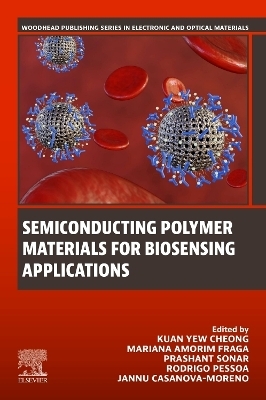
Semiconducting Polymer Materials for Biosensing Applications
Woodhead Publishing (Verlag)
978-0-323-95105-0 (ISBN)
The book concludes with a chapter on theoretical insights for designing sensors, (bio)sensors for medical, food and environmental applications and the future of sensors. This book is suitable for materials scientists and engineers and biomedical engineers in academia or industry.
Kuan Yew Cheong is a Professor in the School of Materials and Mineral Resources Engineering at Universiti Sains Malaysia. His research interests cover device fabrication, surface engineering, nanomaterials, semiconductor materials and devices, and electronic packaging materials. Mariana Amorim Fraga is a Professor in the Electrical Engineering Program, Mackenzie Presbyterian University, São Paulo, Brazil. Her research interests focus mainly on the synthesis and characterization of nanomaterials for the development of sensors, electronic devices, and energy technologies. Prof. Prashant Sonar is ARC Future Fellow and Professor in School of Chemistry and Physics and Centre for Material Science at Queensland University of Technology, (QUT), Australia. At QUT, he established the Organic and Printed Electronic Research group. Currently, he is serving as an Associate Editor of the journal Flexible and Printed Electronics, Material Research Express (Institute of Physics, London), Frontier in Chemistry and Energies (MDPI, Switzerland). Recently, he has been elected as Fellow of Royal Chemical Society (FRSC) and Foreign Fellow of Maharashtra Academy of Sciences (FFMAS). Prof. Sonar is interested in design and synthesis of novel p-functional materials (small molecules, oligomers, dendrimers, and polymers) for printed electronics, (OFETs, OLEDs, OPVs, OLETs, OPDs, and Sensors), perovskite solar cells, bioelectronics supramoleculecular electronic and wearable electronic applications. Prof. Rodrigo Pessoa received an undergraduate degree in Physics from Universidade Estadual Paulista Julio de Mesquita Filho, UNESP (2003), Master of Science degree in the field of Plasma Physics from Technological Institute of Aeronautics (2005) and Doctorate in Sciences in the field of Plasma Physics from Technological Institute of Aeronautics (2009). He is currently a research professor at the Instituto Tecnológico de Aeronáutica. He has experience in physics, with emphasis on Condensed Matter Physics and Plasma Physics, Plasma Engineering, Aerospace Engineering and Microelectronics. He has interest in new types of plasma reactors, new materials and processes for microelectronics, aeronautical/aerospace engineering, micro-electromechanical devices (MEMS), solar cell and nanotechnology. Jannu Casanova-Moreno is an Associate Professor at the Center for Research and Technological Development in Electrochemistry (CIDETEQ) in Mexico. He obtained his B.Sc. in Chemistry from the National Autonomous University of Mexico followed by a Ph.D. in Chemistry at the University of British Columbia, in Canada. He is a member of the National Micro and Nanofluidics Laboratory (LABMyN), where he manages its cleanroom. His research focuses on the modification of electrode surfaces with organic molecules as well as the design of electrochemical biosensors and their inclusion on microfluidic platforms. He is also interested in spectroelectrochemical methods that couple fluorescence and electrochemical techniques. He is a member of the International Society of Electrochemistry (ISE) and currently serves as a member of the editorial board of SN Applied Sciences (Springer).
Section I. Basic Properties and Types of Semiconducting Polymer Materials 1. Introduction to semiconducting polymers 2. Introduction to peptide-based polymers 3. Biopolymers from carbohydrates, peptides, & nucleic acids 4. Polyaniline (PANI) and its relevant properties for biosensors 5. Theoretical design of polymeric semiconductor 6. Tight-binding description of semiconducting conjugated polymers
Section II. Synthesis Methods, Characterization and Processing of Semiconducting Polymer Materials 7. Background to (Electro)deposition of Polymer Films 8. Synthesis of ion-conductive polymers 9. Aqueous deposition of a semiconducting polymer 10. Synthesis and electropolymerization of new sulfur-containing monomers 11. Synthesis of Semiconducting Polymer for Organic Electronics 12. Polymerization of Dye Molecules 13. Electropolymerization of phenol and aniline derivatives 14. Production of nanocarriers made of biopolymers 15. Molecularly imprinted electropolymerized carbon electrodes 16. Immobilization strategies for the development of biosensors
Section III. Biosensing Applications of Semiconducting Polymer Materials 17. Semiconductor Polymers for Biomedical Applications 18. Electrochemical biosensors for determination of tumor biomarkers 19. Semiconductor Polymers for cardiovascular biosensor devices 20. Impedimetric Biosensors for Disease Detection and Monitoring 21. Polymethylene blue nanofilm for creatinine sensor
Section IV. Novel Applications and Future Directions for Semiconducting Polymer Materials 22. Block Copolymers for Skin-Compatible Electronics 23. Biopolymer Based Sensors for Food and Environmental Application 24. Semiconducting polymers for a new generation of electrochemical sensors 25. PEDOT:PSS paper-based electrode for biosensing applications 26. An Overview on Clinical Applications of Biosensors
| Erscheinungsdatum | 23.01.2024 |
|---|---|
| Reihe/Serie | Woodhead Publishing Series in Electronic and Optical Materials |
| Sprache | englisch |
| Maße | 152 x 229 mm |
| Gewicht | 1000 g |
| Themenwelt | Technik ► Elektrotechnik / Energietechnik |
| Technik ► Maschinenbau | |
| ISBN-10 | 0-323-95105-8 / 0323951058 |
| ISBN-13 | 978-0-323-95105-0 / 9780323951050 |
| Zustand | Neuware |
| Haben Sie eine Frage zum Produkt? |
aus dem Bereich


